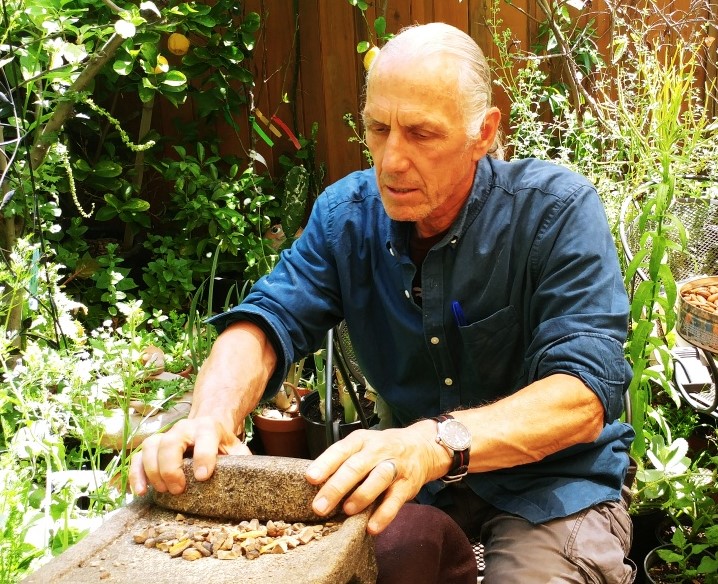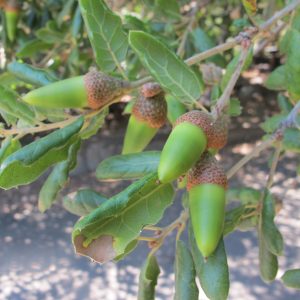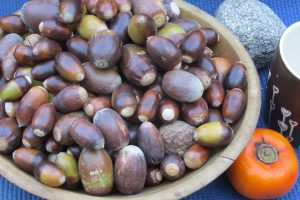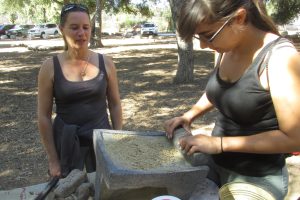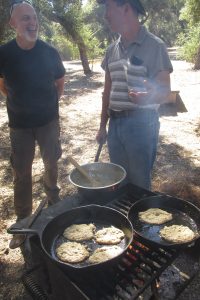ACORNS ARE FALLING
Christopher Nyerges
[Nyerges is an ethnobotanist who has been teaching about the uses of wild plants since 1974. He is the author of 22 books, several of which have many details about the processing of acorns, such as: “Guide to Wild Foods and Useful Plants,” “Foraging California,” “Nuts and Berries of California,” and others. He can be reached at www.SchoolofSelf-Reliance.com, or Box 41834, Eagle Rock, CA 90041]
Acorns are the fruit of the oak tree – a nut set in a scaly cap. Oak trees are the Quercus species, and there are about 600 species of oak trees world-wide. Oak trees are found in every area of the United States.
Oak trees are very diverse, most being large trees, but some being bushes. There are species which are evergreen and those which are deciduous (they drop their leaves as winter comes).
Coast live oak acorns still on the tree
Acorns have been used for millennia for food by the American indigenous people, and in most parts of the world where the acorns are found. But you can’t just pick up acorns and eat them. Because of the presence of bitter tannic acid, they must first be leached in any of a variety of methods.
After I collect acorns in the fall, I typically dry them by placing them in one of my dehydrators, or laying them in the sun. Drying removes the moisture so the acorns will not get moldy if you’re not going to use them right away. Once dried, you could keep them for a few years before you process them.
A bowl of several types of ripe acorns.
Today, on the trail or in the kitchen, the neatest and quickest way to process the acorns is to boil them and change the water repeatedly until they are no longer bitter. At that point, I prefer to process them through a hand-crank meat grinder to produce a coarse meal. You can also dry that coarse meal, and then grind it finer, which you can do in a coffee grinder. The meal is perfect for any product calling for flour. I typically mix the acorn flour 50-50 with wheat or other flours. This is partly for flavor, and partly because acorn flour doesn’t hold together as well as wheat flour, for example.
David Martinez pours water through the acorns that have been placed into a cotton cloth, that has been place inside a colander.
TRADITIONAL PROCESSING
The more traditional method of processing first involves shelling the acorns, and then grinding them while still raw. I typically do this on a large flat-rock metate. The flour can also be processed in a food processor. Then, I put a cotton tea cloth inside a large metal colander, put the acorn flour into the colander, and pour cold water over the acorns. The water takes a while to trickle out, and it may require 2 or 3 or 10 pourings of water before the acorn meal is no longer bitter and can be eaten.
Christopher grinds acorns on a stone metate. Students grind acorns on a metate.
Photo by Helen W. Nyerges.
I have had modern acorn products of chips, pound cake, and pasta. They are delicious. If I had to describe the acorn flavor, I would say that products made with acorn flavor have a subtle graham cracker flavor. There exist at least 3 cookbooks entirely devoted to making acorn food products, such as puddings, bread, cakes, pancakes, pasta, cookies, and drinks.
Buddy (left) and Gary Gonzales cook acorn pancakes.
MEDICINE/NUTRITION
How good are acorns for you? Indeed, just check out this data from a chart that was published in Temalpakh: Cahuilla Indian Knowledge and Usage of Plants by Lowell John Bean and Katherine S. Saubel. Their source was Martin A. Baumhoff, Ecological Determinants of Aboriginal California Populations (Berkeley: University of California Press, 1936, p.162) as modified by Carl Brandt Wolf, California Wild Tree Crops (Claremont, CA: Rancho Santa Ana Botanic Garden, 1945, table 1) and Spencer, Handbook of Biological Data, W. B. Saunders Co., New York, 1956, table 156).
Chemical Composition of Hulled Acorns (in percent)
| Species | Water | Protein | Fats | Fiber | Carbohydrates | Ash | Total proteins, fats, carbohydrates |
| Q. lobata | 9.0 | 4.9 | 5.5 | 9.5 | 69.0 | 2.1 | 79 |
| Q. garryana | 9.0 | 3.9 | 4.5 | 12.0 | 68.9 | 1.8 | 77 |
| Q. douglasii | 9.0 | 5.5 | 8.1 | 9.8 | 65.5 | 2.1 | 79 |
| Q. chrysolepsis | 9.0 | 4.1 | 8.7 | 12.7 | 63.5 | 2.0 | 76 |
| Q. agrifolia | 9.0 | 6.3 | 16.8 | 11.6 | 54.6 | 1.8 | 78 |
| Q. kelloggii | 9.0 | 4.6 | 18.0 | 11.4 | 55.5 | 1.6 | 78 |
| Barley | 10.1 | 8.7 | 1.9 | 5.7 | 71.0 | 2.6 | 82 |
| Wheat | 12.5 | 12.3 | 1.8 | 2.3 | 69.4 | 1.7 | 84 |
Here is Nutritional data about acorns from the USDA.
| Vitamins | Amount | DV |
| Folate | 87.00 mcg. | |
| Folic acid | 0.00 mcg. | |
| Niacin | 1.827 mg. | 9% |
| Pantothenic Acid | 0.715 mg. | 7% |
| Riboflavin | 0.118 mg. | 7% |
| Thiamin | 0.112 mg. | 7% |
| Vitamin A | 39.0 IU | 1% |
| Vitamin A, RAE | 2.0 mcg. | |
| Vitamin B12 | 0.00 mcg. | 0% |
| Vitamin B6 | 0.528 mg. | 26% |
| Vitamin C | 0.0 mg. | 0% |
| Minerals | Amount | DV |
| Calcium, Ca | 41.0 mg. | 4% |
| Copper, Cu | 0.621 mg. | 31% |
| Iron, Fe | 0.79 mg. | 0.79% |
| Magnesium, Mg | 62.0 mg. | 16% |
| Manganese, Mn | 1.337 mg. | 67% |
| Phosphorus, P | 79.0 mg. | 8% |
| Potassium, K | 539.0 mg. | 11% |
| Sodium, Na | 0.0 mg. | 0% |
| Zinc, Zn | 0.51 mg. | 3% |
RECIPES:
TONGVA MEMORIES
Process your acorn flour, and mix half-and-half with whole wheat flour. If you don’t use wheat, use another flour such as amaranth or potato flour. Add an egg if desired. Add water and mix to create a pancake batter consistency. Cook the pancakes on a buttered hot skillet, and serve with butter or jam.
LINDA’S ACORN PASTA
I learned this recipe from Linda Sheer who grew up in rural Appalachia. Blend one-half processed acorn flour with one-half whole wheat flour. Add water as needed, and run it through a pasta machine, creating noodles or whatever sort of pasta you prefer. When cooked, serve with butter, or tomato sauce.
PHOTOS all photos by Christopher Nyerges unless otherwise indicated

